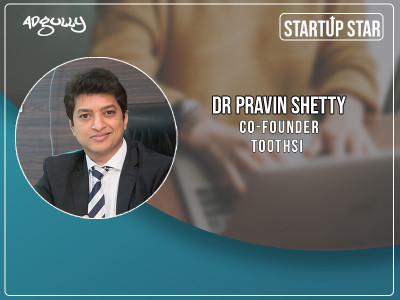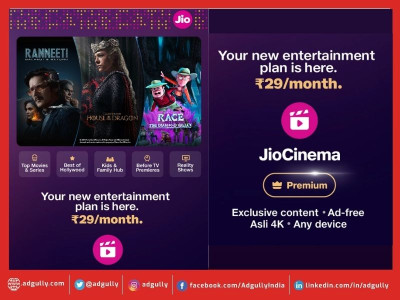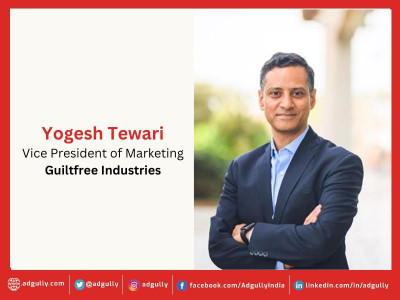We saw 40% Q-o-Q growth since the initial lockdowns: Dr Pravin Shetty
While the global pandemic has bought economies to a halt and massively disrupted businesses, it has also fuelled start-up dreams and we even saw several Indian start-ups achieve Unicorn status during the pandemic period. The times have never been better for the budding entrepreneurs to give wings to their start-up dreams.
The Government, too, has come up with various schemes to support its ‘Vocal for Local’ drive. A case in point is the recent Rs 1,000 crore Start-up India Seed Fund announced by Prime Minister Narendra Modi during the Start-up India International Summit 2021 held earlier this year.
Adgully is turning the spotlight on the entrepreneurs who fought against all odds to bring their dreams to fruition in our special series – START-UP STARS. We at Adgully wholeheartedly support the ‘Vocal for Local’ movement and over the next few months will be featuring all local/ homegrown businesses, brands and Apps.
Toothsi is a start-up founded by Dr Pravin Shetty, Dr Arpi Shah, Dr Anirudh Kale and Dr Manjul Jain, who were all practicing orthodontists before they collaborated and established India’s first and largest at-home smile makeover service brand in November 2018. Dr Pravin Shetty, Co-founder, toothsi, went to Germany to learn lingual orthodontics. Upon his return, he was equipped to offer invisible lingual orthodontic treatment to all the patients looking to correct their crooked and protruded teeth.
However, not only did this technique require higher orthodontic skills, it also required patients to wear braces 24/7. This often led to occasions when a patient would need to book an emergency appointment on account of brackets becoming loose. To address this issue, Shetty went to France and Korea to learn more about aligner technology which was present in the US and Europe. Having received his training, Shetty returned to set up his laboratory and 3D printing unit in India and tried to make aligners more affordable for customers in the country. Over a period of time, the four orthodontists launched toothsi Clear Aligners with the aim to offering all demographics the opportunity to sport a confident smile irrespective of which age group they belong to.
Shetty’s toothsi journey is an extension of his commitment to the field of orthodontics, in which he continues to serve various roles. He is the first orthodontist in India to develop and patent the country’s first CAD/CAM-based lingual orthodontic system, known as Lingualmatrix.
In an exclusive conversation with Adgully, Dr Pravin Shetty, Co-founder, toothsi, speaks about how this company founded by orthodontists is catering to customers’ dental requirements, introducing technological innovations, as well as plans to become an end-to-end provider of smile makeover services, and more.
What gap did you want to fulfill with your start-up? What is the core business proposition?
During the conceptualisation of toothsi, our interactions with different stakeholders helped us confirm the need for better teeth-straightening services in India. Getting metal braces has been the conventional option available to people seeking smile correction services. The absence of a less-conspicuous alternative meant that adults who are required to navigate various social spheres would typically decide to forego this service altogether. This is because the prevailing belief has been that orthodontic treatment is best suited for individuals below 20 years of age. Through Clear Aligners, we aim to challenge this notion as we strongly believe that every person, irrespective of age, deserves to be given access to smile correction services aligned with their preferences, sensibilities, and needs.
Instead of metal braces, we provide our customers with invisible dental aligners crafted using best-in-class materials and advanced technology. These aligners are specifically designed according to each customer’s dental requirements, making the experience of wearing them super comfortable. At toothsi, we follow a D2C, customer-oriented model to enhance customers’ experiences at each step of their smile correction journey.
We have benefited from the first-mover advantage of being a smile makeover brand that offers teeth straightening service at the customers’ homes. As soon as a customer fixes an appointment with us, a scan of their dental structure is conducted followed by an in-depth analysis by our team of expert orthodontists. The tech-enabled analysis allows us to provide our customers with a preview of how their smile will look post-treatment. Once it is approved by the customers, the toothsi aligners are manufactured and delivered to them.
How did you identify your TG? Did you carry out any feasibility study prior to starting your business?
People around the world usually have their first orthodontic consultation by the age of 7. However, in India, dental care is not prioritised until early adulthood. As a result, the idea of getting metal braces for almost 2 years discourages many from seeking teeth straightening services. In fact, less than 10% of more than 600 million Indians access smile correction services. At toothsi, we aim to deliver state-of-the-art technology and a best-in-class digital aligner system to all the individuals looking to get their smiles corrected discreetly and cost-efficiently on the back of invisible, removable, and customised dental aligners. Our dream is to make this technology available to every Indian so that they can flaunt a confident smile and lead an active social life.
Our prime target audience includes young, aspirational urban consumers falling in the age bracket of 18-35 years. This is the age group that could not access teeth-straightening services in their childhood due to reasons ranging from a lack of awareness to financial constraints. Today, these individuals are part of India’s affluent workforce with a growing disposable income on their hands. Consequently, young adults in the country are increasingly accessing smile correction services. However, they want the orthodontic treatment to take place discreetly, a provision that traditional metal braces do not allow for. Clear Aligners perfectly meets the requirements of the modern Indian. The logistical convenience enabled by at-home scanning facility and digital consultation during the COVID era is another crucial factor contributing to the growing popularity of modern smile makeover services among the new-age Indian customers.
What were the challenges that you faced in your start-up journey and how did you overcome them?
Toothsi’s journey since the beginning has been exciting, satisfactory, and consistent. We have been fortunate enough to witness more ups than downs in our journey so far. Since its conception, the idea of a convenient and hassle-free teeth correction was alien to our prospective clients as well as investors. In fact, we received some 25-odd queries within a month of our website’s launch, inquiring about the product and how it works. Thus, began our journey where these initial few customers helped to spread the word by posting testimonials, reviews and pre- and post-treatment images to keep the momentum going. We are grateful to have designed more than 25,000 smile plans so far. Customer advocacy and word-of-mouth have helped us maximise our outreach campaigns. We have also spent a good amount of time in educating people and peers by providing appropriate content across channels.
Our internal growth journey is a reflection of our business growth. From a team of 15 talented and dedicated orthodontists, we are now a team of more than 1,000, including tech enthusiasts, veteran orthodontists, dentists, and business-minded individuals, working in partnership with more than 2,000 clinics across 13 cities in India. These include Mumbai, Delhi, Bangalore, Chennai, Surat, Chandigarh, Indore, Pune, Jaipur, Hyderabad, Lucknow, and Ahmedabad.
When we started in 2018, the prospects were looking optimistic. Then COVID-19 arrived on Indian shores in March 2020. The harsh lockdowns made it difficult for us to reach out to our customers and keep our operations running. However, our determination and vigor kept us going such that we were able to get our operations back on track during, and despite, the pandemic. Our tech system empowered our orthodontic experts to conduct treatment planning, share files and data, and connect with patients for monitoring and consultation remotely. Our tech infrastructure also allowed us to manufacture clear aligners and deliver them to the customers at their doorstep.
The convenience enabled by a customer-centric focus coupled with strict compliance with safety protocols increasingly encouraged the customers to embrace our services. As a result, we managed to clock a 40% quarter-on-quarter growth since the initial lockdowns were implemented. Another major factor that contributed to the increased demand for smile makeover services is that the lockdowns gave people the opportunity to focus on self-care and try things they had been postponing until then. Beyond self-care, people recognized the importance of teeth straightening on account of the rise of videoconferencing as the primary mode of professional meetings. Video calls exaggerate the features of the face, which made prospective beneficiaries conscious of their smiles, thereby feeding their desire to sport a more confident smile.
At toothsi, we were equipped to address this growing need-gap. Our goal is to establish ourselves as an end-to-end provider of smile makeover services. This includes educating the prospective beneficiaries of the treatment about its benefits to designing the ideal smile plan for each customer and monitoring their progress to ensure that each customer can possess the smile they desire.
Funds/ finance is the prime issue of almost all start-ups. What can the industry and the Government do to address this issue and ease the capital requirements of start-ups?
The government must focus on improving the infrastructure across the value chain for primary, secondary, and tertiary sectors. The focus has always been there but, especially in the post-pandemic landscape, the development needs to be accelerated if we are to emerge from the throes of the viral outbreak better, healthier, more prepared and prosperous. The start-up ecosystem is resilient and also comprises the key to unlocking the accelerated post-pandemic recovery and subsequent progress. To make that process more seamless, the government should look to institute a one-window system for offering clearances across all the levels to fast-track the administrative processes and ease the regulatory friction. The government has already set up accelerator and incubator programs and has instituted funds to bolster the start-up activity in the country. The country’s economic growth, in part, will also hinge on how much and how soon the government can ramp up the scale and speed of these policy measures to drive sustained growth. In 2019, the government took a welcome step of exempting DPIIT-registered start-ups from the ambit of angel tax. The government can take more of such steps to offer more tax benefits to young start-ups to aid their growth journey.
Prime Minister Modi has just announced a Startup India Seed Fund. How do you see start-ups benefiting from it?
India is home to more than 41,000 start-ups, with more than 30 start-ups in the elite Unicorn club. This makes India the third-largest start-up ecosystem in the world. There are many high-potential ideas that could be established as start-ups; however, many ideas seldom flourish mainly due to a lack of adequate funding. I believe that the Startup India Seed Fund can remove the financial obstacle from the entrepreneurial journeys of many ventures, especially at the product trial stage. This government initiative is inclined to prove beneficial for the start-up sector by empowering entrepreneurs hailing from Tier 2 and Tier 3 cities as well. Doing this will consolidate India’s position as one of the world’s top start-up ecosystems.
How is digital helping you further your business?
Our business model is primarily D2C, which enables us to deliver services digitally, minimising in-person interaction across the treatment period. Customers have the option of fixing an appointment with toothsi professionals for a free-of-charge digital intra-oral scan at their homes.
Following this step, everything takes place remotely. We have associated with one of the world’s top intra-oral scanner manufacturers based in Denmark. We have integrated their digital technology to enable seamless transfer of digital files to and from the customer sitting in any location in India. The aligners are then manufactured based on scan results and delivered to the customer with the necessary paraphernalia. Customers are then required to consult the orthodontic experts digitally. This approach minimises the physical contact environment across the value chain. Naturally, this model has proven to be even more successful in the post-pandemic landscape.
Moreover, leveraging the virtual space has helped us in scaling our operations to the increasing demand without compromising on efficiency. For instance, tools like video calling enable our customer service team to provide continued support to our customers throughout their journey with toothsi. We are also deliberating to start a hybrid model incorporating the best of both physical and digital worlds, once the pandemic subsides.
What were your key learnings from 2020? How do you see the start-up ecosystem progressing in 2021?
The advent of the pandemic forced the business world to transform the way it was used to functioning. The new normal was dictated by restrictions on physical movement and congregation. This meant that brands needed to find new ways of engagement that did not rely on in-person interactions. This is where digital technology stepped in to help businesses work around the said challenge. If there is one key takeaway from the past year, it is that technology is our friend. Another lesson is that discerning brands are agile: they can shift their sails in sync with the shifting tides and flow of winds. Businesses that were unable to transform their strategies found it more difficult to survive the post-pandemic storm. On the other hand, businesses that were in step with the latest developments were able to weather this storm.
However, the future of the start-up ecosystem is not just digital, it is also empathetic. The pandemic-led isolation and loss of human touch led people to recognise the value of social interactions that they took for granted before 2020. Brands need to be mindful of this change in consumer sensibilities if they are to effectively reach out to them. Because customers seek and value empathy not just in the way services are delivered, but also in the way brands engage with them. In line with this twin focus, brands must become empathe’tech to acquire, retain, and engage with customers in the long run. Finally, the pandemic taught us that newer challenges can open up different avenues. Discerning brands that can turn adversities into opportunities will be able to survive and thrive in the wake of any disruption in the future.
What would be your message for the budding entrepreneurs?
The only thing constant in life is change. We must always be prepared to embrace the change and reconfigure our strategies in its wake. The future is unpredictable. Therefore, the only certainty in your entrepreneurial journey will need to come from your end: the certainty of determination, perseverance, and continued innovation. While it may not be possible to control what happens to you, you can indeed control how you react to it. For this, entrepreneurs must inculcate agility and be forever invested in the habit of continuous learning, unlearning, and re-learning. This is how you can identify and capitalise on the opportunities that will help you advance towards your vision. Finally, when in doubt, it is a good habit to default to a people-first approach to decision-making. True empathy is reflected in the decisions you make not just when it comes to business outcomes, but also within the organisation.


















Share
Facebook
YouTube
Tweet
Twitter
LinkedIn